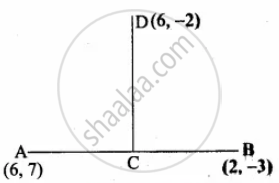Advertisements
Advertisements
प्रश्न
Find the equation of a line passing through (6, −2) and perpendicular to the line joining the points (6, 7) and (2, −3)
उत्तर
Let the vertices A(6, 7), B(2, −3), D(6, −2)
Slope of a line = `(y_2 - y_1)/(x_2 - x_1)`
Slope of AB = `(-3 - 7)/(2 - 6) = (-10)/(-4) = 5/2`
lope of its perpendicular (CD) = `-2/5`
Equation of the line CD is y – y1 = m(x – x1)
y + 2 = `-2/5(x - 6)`
5(y + 2) = – 2(x – 6)
5y + 10 = – 2x + 12
2x + 5y + 10 – 12 = 0
2x + 5y – 2 = 0
The equation of the line is 2x + 5y – 2 = 0
APPEARS IN
संबंधित प्रश्न
Find the slope of the following straight line
5y – 3 = 0
Find the slope of the following straight line
`7x - 3/17` = 0
Find the slope of the line which is perpendicular to the line x = – 11
Check whether the given lines are parallel or perpendicular
5x + 23y + 14 = 0 and 23x – 5x + 9 = 0
A(−3, 0) B(10, −2) and C(12, 3) are the vertices of ∆ABC. Find the equation of the altitude through A and B.
Find the equation of a straight line joining the point of intersection of 3x + y + 2 = 0 and x – 2y – 4 = 0 to the point of intersection of 7x – 3y = – 12 and 2y = x + 3
The straight line given by the equation x = 11 is
The equation of a line passing through the origin and perpendicular to the line 7x − 3y + 4 = 0 is
Consider four straight lines
(i) l1; 3y = 4x + 5
(ii) l2; 4y = 3x – 1
(iii) l3; 4y + 3x = 7
(iv) l4; 4x + 3y = 2
Which of the following statement is true?
A person standing at a junction (crossing) of two straight paths represented by the equations 2x – 3y + 4 = 0 and 3x + 4y – 5 = 0 seek to reach the path whose equation is 6x – 7y + 8 = 0 in the least time. Find the equation of the path that he should follow.
